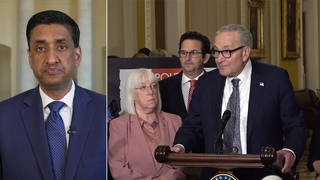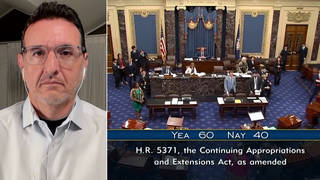
Award-winning New York Times columnist Paul Krugman addressed a packed crowd in Manhattan last week at an event titled “The New Class War in America.” We play an excerpt of his address. [includes rush transcript]
Award-winning New York Times columnist Paul Krugman spoke last week at an event here in New York entitled “The New Class War in America.” In addition to his work as a New York Times columnist, Krugman is also a professor of Economics and International Affairs at Princeton University. He is the author of several books, including “The Great Unraveling: Losing Our Way In The New Century.”
- Paul Krugman, columnist for The New York Times, speaking June 13th, 2006.
Transcript
AMY GOODMAN: We spend the rest of the hour with Paul Krugman, the award-winning New York Times op-ed columnist. He spoke recently in New York about the new class war in America. In addition to writing for the Times, Paul Krugman is a world-renowned economist. He teaches at Princeton University.
PAUL KRUGMAN: I was actually trying to get a sense — I know I’ve been working with statistics, but I was trying to get a sense of what this America that we seem to have lost was like. And I went — have been going back and reading. Now, Time magazine had kind of a survey of just, you know, what was the country like in 1953 after the election of Dwight Eisenhower. And what they said, the article began: “Even in the smallest towns and most isolated areas, the U.S. is wearing a very prosperous middle-class suit of clothes and an attitude of relaxation and confidence. People are not growing wealthy, but more of them than ever before are getting along.”
Now, that wasn’t really fair, even in 1953. Certainly if you had the wrong skin color, if you were living in the wrong parts of the country, you wouldn’t have agreed with that picture. But it was true of a lot of people. In fact, America really was a middle-class society during the '50s and ’60s. Not everyone. Not large segments of the population. But it was a relatively middle-class society, a relatively even distribution. And there were not a lot of very wealthy people, either. It's not just that more people than ever before had a decent standard of living, but that the extremes, the plutocracy, seemed to have been pretty much tamed and, to a large extent, eliminated.
You would never say that about the country now. You would say, gee, we are now a country of great extremes. We are a country in which more and more people are having a hard time maintaining what the essentials of a middle-class existence — to say, just to take the cutting edge of the degeneration, health insurance. More and more people losing that sort of basic security of life. Job assurance.
If you look at the long sweep, here’s what you see about America. Once upon a time, there was the Gilded Age, period of enormous wealth, plutocracy. That lasted a lot longer than the history books would tell you. The Gilded Age is usually thought of as something that ended once intellectuals began speaking about changing it. But it didn’t, of course. It was really pretty much in place. All that wealth and privilege and widespread poverty and enormous gaps lasted right up into the 1930s. As far as we can tell, there was really no difference in the amount of inequality in 1929 from what it had been in the pre-World War I period.
Then, we became a middle-class society. We became a society — the one that, again, allowing for Time magazine sort of missing a lot of people in that story, we became that relatively broadly based prosperity, which is the country I grew up in. And then, we became again a dramatically unequal class-ridden society. And if you, if you look at the numbers and also just look around you, we are really back, in all essential respects, to Gilded Age levels of class differences and barriers.
I do like my statistics, but I also like the impressionistic things. And one of the things I’ve always tended to look at is real estate. Specifically, how ordinary people live, but also how the wealthy live.
And if you were to go back, the shores of Long Island Sound are a good place to sort of catch an index of what’s happening. In the Gilded Age and up through the '20s, into the ’30s, the shores of Long Island Sound, both the North Shore of Long Island and the Connecticut coast, were where the super wealthy built their mansions. They were gigantic piles, huge things where people lived. By the time I was growing up, the mansions, most of them, were still there physically, but they were no longer private mansions. People couldn't afford them. They were between the really serious diminution of the wealth of the wealthiest, taxes, income taxes, lower incomes, the estate taxes, and the fact that also Americans were too well paid to be hired as servants to maintain those things. Most of them had been given up. They had been sold for very little to become schools and nursing homes, or they had actually been given away and become museums or government buildings.
Today, well, there was a story actually. The current Vanity Fair. Interesting thing how sometimes the best reporting is not coming sort of from the Washington Post, but from magazines. The story was actually mostly prurient interests, but it’s pretty interesting anyway, about Greenwich — Greenwich, Connecticut — where there are still a lot of the old Gilded Age mansions there. And it turns out that what’s been happening in Greenwich is that hedge fund managers have been buying up the Gilded Age mansions and knocking them down to build much bigger residences. The typical ones that they’re describing now are about 30,000-plus square feet, which is about the size of the Taj Mahal. So that’s about — that’s the impressionistic thing.
Turns to the numbers just to say — and this can easily become a grind — but it’s worth saying, the important thing to realize about what’s happened to America, both the flattening of our income distribution that happened in the middle of the century and the widening out that’s happened again is, it’s not a story about the top quarter of the population pulling ahead or the top 15%. The great bulk of the action is really a few percent, in many cases just a very, very small number of people. If you were to look at the — there’s been a large rise since the 1970s in the share of income that’s gone to the top 10% of the population. I’ve gone through that. And if you work it out, it turns out that most of that rise is actually the top 1% of the population. And about half of it is the top 0.25% of the population, which means at the moment, or actually 2003, which is the last date for which we have it, people with incomes of more than $750,000 a year.
So we’re really not talking about — you know, you will hear stories that say, well, you know, people with good education and skills are pulling away from the rest of the population. Well, it’s true that, by and large, people who are earning $750,000 or more a year have college educations. But not everybody, right? It’s like I like to say, the Fortune 500 CEOs and high school teachers have about on average the same number of years of education. They’re not exactly experiencing the same pay raises. So this is tremendous elitism.
Now, why does all of this matter? It matters because — partly because it just means that most people are not sharing in economic growth. And the standard of living of the typical American family is — well, is it higher or lower than it was 30 years ago? You know, we can ask that question, but the fact that you even have to ask is telling you something. It’s close enough. Consumption of material goods seems a little bit higher, but job security is clearly a lot less. People are working longer hours. The risk of losing health insurance is much greater. The difficulty of getting your kids into a decent school is much harder. So it’s a mixed picture, but certainly not the — if you had asked in 1973, “Are people better off than they were in 1947?” people would have had — there was no question. Enormous progress. If you ask that now about 30 years ago, it’s not at all clear what the answer is. It’s only the top few percent of the population that have had enormous gain. So that’s one thing. We’ve had an economic growth, but it hasn’t been broadly shared.
But I actually think that that’s almost the least of it. Much more important is what this polarization of incomes does to our society. Now, there’s part of it that I can’t document too well, but I’m working on, which is, I think it actually just poisons the feeling of our society. And there is a reasonable amount of evidence that having a highly unequal society undermines the trust that people have in each other, because they don’t believe that we’re all in the same boat, that it actually increases corruption.
One of the — as you know, John Kenneth Galbraith died recently. And I’ve been reading his book, The New Industrial State, which was a fantastic portrait of the way American business, American capitalism, was in the '60s, but he thought it would persist forever. And it didn't. One of the things he says there at length is that the whole issue that, you know, corporate executives might engage in self-dealing, that they might enrich themselves at the expense of the corporation, is just nothing to worry about. There’s no problem on that. And that was probably true around 1967.
You ask: why has that changed? And one of the answers is, well, you know, in the days when executives were paid like government officials, the incentive to lie and cheat — you know, you might get yourself a promotion, a bit larger salary, but if you were caught, that was the end of your career. Now if you lie and cheat, you can walk off with a couple hundred million dollars after a couple years, and if you are then booted from the company, you can probably find a way to not — unless you are really, really stupid, you won’t get convicted by a jury — you know, Ken Lay, okay, but Richard Scrushy walked away — and you’re set. So the incentives, the inequality in itself, creates the possibility of corruption in a way that wasn’t there before.
And there’s the political process. Let me tell you a historical story I’ve been working on quite a lot. Before the New Deal, there was a movement, there was an attempt to — there was a progressive movement. People did try for reform. And the great reformist of the time was Al Smith, the governor of New York, who was a poor kid who made his way up and retained, at least for a while, his feeling for the kind of people he grew up with and ran a very serious campaign for reform, for what would have been a sort of proto-New Deal policy in 1928. And it was at that point one of the ugliest campaigns ever in American history. Now, they could have — the trouble was that basically most people would have stood to benefit from the kinds of things Al Smith was advocating.
So what was the Republican Party, which at that time, by the way, the Republican Party had fundraising offices in every state, plus one for the North Shore of Long Island, where there were 500 mansions, just to give you a sense of how things worked, who ran the party. Well, they had to find something, so what they found was that he was a — gosh, he was an Irish Catholic. And so, there was this horrifying smear, cultural fears campaign against Al Smith, with burning crosses and everything, that managed to swing a number of Southern states, which being relatively poor, actually would have stood to gain quite a lot from his policies, that turned a lot of those states against him. And so, they were able to exploit, you know, cultural divisions, but although fundamentally there’s no evidence that the people were actually running — this is Herbert Hoover’s campaign — there’s no evidence that Herbert Hoover was himself a violent anti-Catholic bigot or that the people running his campaigns were, but they had found an issue that they could use to sort of — does this all sound kind of familiar? Right? And I think that’s true.
Now, what I can say for sure, and actually some of my colleagues at Princeton in the politics department work on, have done very interesting work on politics, and what they show is that the polarization of politics, which you can measure, and, I would say, the nastiness, which is very — you can’t exactly measure, but it’s very closely correlated, is very much — it rises and falls with income inequality.
Periods, the Gilded Age, the '20s, were periods of grotesque abuse of cultural issues, anything to smear people who might suggest things like, you know, progressive taxation. And times when those kinds of views, when everyone had more or less accepted the existence of the New Deal institutions, were quite calm. So that same Time magazine article in 1953 is saying Republicans and Democrats have a surprising sameness of outlook and political thinking, and that makes a big point about how Eisenhower had made it clear that he was not going to try to roll back the New Deal. Well, that's why we — that’s a consequence of being a relatively equal society. And the ugliness and the viciousness of our political scene right now, I think, are in fact largely a consequence of the gross inequalities that have emerged.
Why? How did we — what happened? There’s a tendency to say, well, it’s, you know, it’s these impersonal market forces, or maybe it’s globalization requires inequality, or just technology. There’s always some truth to that kind of thing, but much less than you might imagine. I’ve already mentioned a little bit about education. We keep on hearing that technology creates this premium for the education for the creative classes, whatever it might be. It turns out that that’s really — put it this way, the median college-educated American has, unlike the median non-college-educated American, actually seen some gains in income over the past 25 years. But they’re tiny. It was less than one percent a year on average and, in fact, over the past five years, college-educated workers, most college-educated workers, have actually seen their incomes fall, once you adjust for inflation. It’s not actually true that a college education is the key to being successful. It’s being part of the tiny magic circle of the economic elite that gets you ahead. So it really isn’t about education. It isn’t about skills.
A little bit of it is about, you know, we like to talk about human capital being what matters. If you actually look at the last five years, human capital has been losing, but good old capital capital has actually been doing extremely well. Share of profits in national income is at its highest level since 1929. But it’s not at least that particular impersonal market force. And a lot of it looks like it’s — in fact, it’s the political process does a lot to drive the distribution of income, partly, of course, taxes — there’s taxes which tax the rich and provide benefits to everyone at large — but also other things, whether you have a political environment that basically assures workers of the right to organize or one that basically is sympathetic with employers who try to break unions, whether you have a general set of political pressure that says, that fairness is a good thing or that says that greed is good.
AMY GOODMAN: Paul Krugman, the New York Times op-ed columnist, author of the book, The Great Unraveling, a collection of his columns, speaking last week at the New York Ethical Culture Society in the launch of Greg Palast’s book called Armed Madhouse.












Media Options